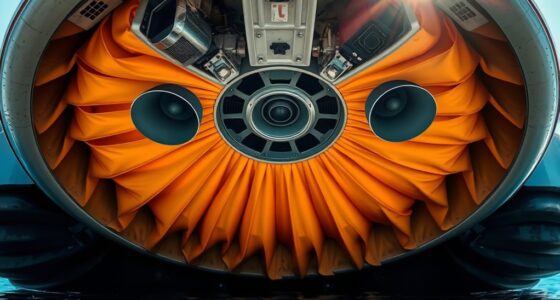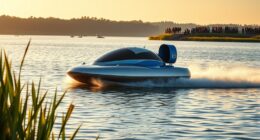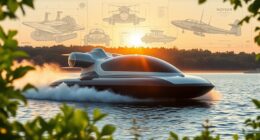To anchor a hovercraft without an anchor, choose a stable, flat surface like shallow water, firm ground, or ice that can hold the craft in place. Use natural features such as shoreline, reeds, or rocks to help stabilize it, and consider deploying mooring lines or tie-downs designed for hovercraft. Slowly settle the craft, ensuring it’s secure without causing disturbance. Keep monitoring conditions and options—you’ll find more ways to secure your craft effectively as you go.
Key Takeaways
- Utilize natural features like shoreline, reeds, or rocks for stabilization without anchoring.
- Employ temporary mooring lines or tie-downs to secure the hovercraft in place.
- Choose calm, flat surfaces such as water or firm ground to minimize drifting risks.
- Use environmental elements like currents or wind direction to assist with natural stabilization.
- Gradually slow down and carefully position the craft to reduce surface disturbance and enhance stability.

Have you ever wondered how hovercraft owners find convenient and secure places to park their vessels? It all begins with mastering navigation techniques that allow you to identify suitable locations without the need for traditional anchors. Since hovercraft can operate on a variety of surfaces—water, mud, sand, or even ice—you need to be able to assess the terrain quickly and accurately. Using GPS and depth-sounding tools, you can pinpoint areas that offer a stable, flat surface with minimal risk of drifting or becoming stranded. Observe the water or surface conditions carefully: look for calm waters or firm, level ground that won’t shift unexpectedly. Understanding tides, currents, and wind directions is essential because these factors influence how your hovercraft behaves when stationary. By planning your parking spot with precise navigation techniques, you reduce the chance of drifting away or encountering hazards like submerged objects or soft ground that could cause instability.
Alongside navigation, adhering to strict safety protocols is vital when parking without an anchor. Always ensure your hovercraft is equipped with safety gear, such as life jackets, signaling devices, and communication tools, to respond quickly in case of emergencies. Before settling into a parking position, communicate your intentions clearly to any nearby vessels or personnel to avoid misunderstandings. When you find a suitable spot, slow down gradually so you don’t unsettle the surface or cause damage. Use environmental features—like a shoreline, reeds, or rocks—to help stabilize your craft naturally, but only if they’re safe and appropriate for parking. If you’re on water, consider deploying temporary mooring lines or using specialized tie-downs designed for hovercraft. These help prevent unwanted movement without relying on traditional anchors, which might be unsuitable in certain conditions.
Frequently Asked Questions
Can Hovercrafts Be Parked Overnight Safely Without Anchors?
You can park your hovercraft overnight without anchors if you guarantee proper floating stability and follow emergency procedures. Use mooring lines to secure it to fixed structures or tie it to docks to prevent drifting. Check weather conditions beforehand, and always have safety measures in place. This proactive approach helps maintain stability and readiness for emergencies, ensuring your hovercraft stays safe and secure overnight without the need for an anchor.
What Are the Best Surfaces for Hovercraft Parking?
You should look for a smooth, firm hovercraft surface to guarantee parking stability. Ideal surfaces include well-maintained grass, compacted gravel, or paved areas, as they provide a stable base that prevents shifting. Avoid soft, uneven, or loose surfaces like sand or mud, which can compromise balance. Choosing the right surface helps keep your hovercraft secure overnight without the need for anchors, giving you peace of mind.
How Do Weather Conditions Affect Hovercraft Parking Stability?
Weather impact, wind stability, and changing conditions directly influence your hovercraft’s parking stability. When wind picks up, it can push your craft off course, making it harder to stay secure. Rain and storms can weaken surfaces and cause slippery conditions, increasing risks. You must stay alert to weather forecasts and adjust your approach accordingly, ensuring your hovercraft remains steady and safe, no matter what the weather throws your way.
Are There Legal Regulations for Hovercraft Parking Zones?
You should check local regulations to understand legal restrictions for hovercraft parking zones. Many areas require parking permits, and there may be specific rules about where you can park your hovercraft. It is crucial to follow these regulations to avoid fines or penalties. Always verify with local authorities or maritime agencies to ensure you’re compliant with parking laws, especially in designated hovercraft zones, to keep your craft safe and legal.
What Maintenance Is Needed After Parking Without an Anchor?
After parking without an anchor, you need to perform regular dock inspections to guarantee your hovercraft remains secure and identify any damage. Additionally, you should clean the hull to prevent corrosion and buildup from prolonged exposure to water and environmental elements. These maintenance steps help preserve your craft’s condition, ensure safety, and prepare it for your next use. Consistent care keeps your hovercraft in ideal shape, even when anchored indirectly.
Conclusion
You now know how to park your hovercraft without an anchor, ensuring stability even in tricky spots. Imagine you’re at a busy marina, and instead of struggling with traditional anchors, you use a combination of mooring lines and inflatable bumpers to keep your craft secure. This method saves time and reduces wear on your craft’s hull, making your hovercraft parking safer and more efficient. With these techniques, you’ll confidently anchor without an anchor every time.










